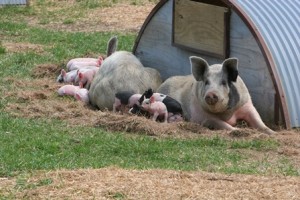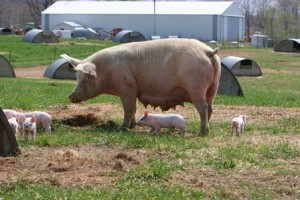Pig Diseases
Clostridial Disease in Pigs
Also known as: Enteritis – Necrotic, Tetanus
What Causes Clostridial Disease in Pigs?
Clostridia are soil and fecal borne organisms that form spores (sporulate) and can survive for a very long time, even in inhospitable environments. Therefore outdoor herds are at greater risk of Clostridial disease than indoor herds. Sheep are also susceptible to clostridial disease, however, it is not necessary for pasture to have been grazed by sheep to create a risk to pigs.
Clostridial infection can affect pigs of all ages and clostridial disease can take one of four forms:
- Clostridial enteritis associated with Clostridium perfringens Types A & C
- Clostridium novyi causes necrotic or anaerobic hepatitis in sows and older growing pigs
- Clostridium septicum infection (often called malignant oedema) causes clostridial cellulitis and gas gangrene in swine with open wounds (Songer and Taylor, 2013).
- Clostridium tetani causes tetanus, although this is uncommon
Cl. novyi infections in particular can be a major problem in outdoor pigs, though not exclusively. Suboptimal outdoor environment and high outdoor infection pressure were cited as potential contributors to sow mortality caused by Cl. novyi on an outdoor pig unit (Almond and Bilkei, 2005).
Cl. septicum and Cl. tetani can be widespread in soil, and therefore may be a risk to outdoor units.

Clostridia are soil and fecal borne bacteria, and the spores they produce are very resistant to heat, UV light and disinfectant. Clostridial species are often associated with outdoor herds due to the abundance of the spores in the soil.
Clostridial enteritis
Enteritis may affect only 3 or 4 litters in a herd (Taylor, 1995) but can also cause large-scale outbreaks. Cl. perfringens Types A and C are common sources of infection (Types B and D are extremely rare). Cl. perfringens Type C is a primary pathogen and the most frequently occurring form, causing necrotic and hemorrhagic enteritis (Potter, 1998; Songer and Taylor, 2013). It can colonise after other pathogens such as transmissible gastroenteritis (TGE) virus, coccidia, rotavirus, and porcine epidemic diarrhea virus. Type C disease typically occurs in the first 3-4 days of life, but has been recorded in older piglets (Songer and Taylor, 2013). When infected with Cl. Perfringens Type C piglets will show signs of enteritis in the first or second day, producing sudden, profuse bloody diarrhea (Cowart, 1995). Piglets rapidly lose condition, become dehydrated and die. Acute neonatal clostridial enteritis can wipe out whole litters before clinical signs develop, resulting in high levels of mortality. When formed, the spores from Cl. perfringens Type C persist in the environment by virtue of their resistance to heat, disinfectants, and ultraviolet light. The disease cycles through non-vaccinated piglets but the ultimate source of infection is the intestine of the sow (Songer and Uzal, 2005).
Cl. perfringens Type A is part of the normal flora of the pig intestine, hence can be found in the intestines of both healthy and diseased individuals (Songer and Uzal, 2005). Type A disease usually develops in the first week of life, presenting as creamy, pasty diarrhea and a roughened hair coat. Clinical signs persist for up to 5 days, following which most piglets recover but remain stunted. Sows are the likely source of infection (Songer and Uzal, 2005).
See: NADIS Pig Disease Focus – Clostridial perfringens infection in piglets
Clostridium novyi
Cl. novyi causes necrotic or anaerobic hepatitis and affects older stock, particularly sows (Potter, 1998; Songer and Taylor, 2013). Necrotic or anaerobic hepatitis results in sudden death, and is often not well diagnosed, as carcasses decompose rapidly (Potter, 1998).
Clostridium septicum (Malignant Edema)
Cl. septicum can be widespread in the soil, and is therefore a risk factor for outdoor units. Clinical signs develop rapidly, as swelling, often around the abdomen, head or shoulders. The area of swelling may show reddish purple colouring of the skin, which spreads rapidly. Movement may be affected by swelling, and latterly animals lie flat and may groan (Songer and Taylor, 2013). This disease is rapidly fatal.
Clostridium tetani (Tetanus)
Cl. tetani infections can affect all ages, but most commonly disease occurs in young piglets with open wounds, including the umbilicus, or wounds left by castration, tail docking or teeth clipping. Tetanus infection is characterised by stiff gait and muscle spasms. As infection develops, the animal’s ears become erect, its tail may straighten and eventually the animal will lie prone (Songer and Taylor, 2013). Spasms continue until death, heightened by localized sound, touch or movement. Infection is often fatal (Songer and Taylor, 2013).
Control and Prevention Clostridial Disease in Pigs
Clostridial infections are closely associated with lack of hygiene and sanitation.

Enteritis caused by Clostridia is usually spread via piglet-to-piglet contact, or through maternal feces. Infection can be minimized by good hygiene protocols, such as moving and re-bedding farrowing huts onto new ground after every litter.
Enteritis is spread through piglet-to-piglet contact and maternal feces (Songer and Taylor, 2013). The maintenance of high levels of hygiene through regular replenishment of bedding, disposal/burning of used bedding, disinfecting of farrowing huts between litters, and the regular movement of individual huts and farrowing paddocks will minimize infections.
Vaccination is recommended as a control strategy, particularly in outdoor herds, due to the increased risk of infection. The prophylactic use of antimicrobials is not recommended as it is not a sustainable strategy. Vaccination of the sow will protect against Types B, C and D. The vaccine Clostriporc A made by IDT is available in the EU and could be imported under licence from the Veterinary Medicines Directorate (VMD) if Type A is confirmed in a clinical case.
Where Cl. novyi is recognised as a problem in sows, vaccination with an appropriate polyvalent vaccine is highly effective. With the exception of a combined E. coli/Cl. perfringens vaccine, which has been developed specifically for pigs, the polyvalent clostridial vaccines were developed for sheep and cattle and cross-licensed for pigs. Where supply problems occur with a pig-licensed product, it is possible under veterinary prescription alone, to use a product that is only licensed for sheep, however, a licensed vaccine for pigs should be the first choice if available.
Tetanus and Cl. septicum infections are less common, but good sanitation and steps to minimize initial wounds are important. Poorly maintained huts or feeders with sharp corrugated edges are another common source of wounds and cuts. If castration is carried out, good sanitation is critical in avoiding tetanus infection. If either Cl. septicum or Cl. tetani are a problem, these are included in the multivalent ovine vaccines. In this instance, ovine vaccines could be used under the rules of the VMD cascade.
Vaccines offer effective protection for herds with a history of the disease (Potter, 1998). In the higher risk outdoor situation, vaccination can be cost effective. On infected land, a vaccine programme to control Cl. perfringens Types B and C could be implemented. Vaccination should be based on a risk assessment and should be incorporated within the health plan.
Prompt disposal of suspect carcases by incineration or collection by a disposal agent, will minimize spread of spores. Carcases should not be buried as this can lead to soil contamination.
Treating Clostridial Disease in Pigs
Treatment of clostridial infections is limited by the fact that clinical signs often indicate advanced infection. Veterinary advice should be sought for accurate and prompt diagnosis, including antimicrobial sensitivity testing where appropriate. Penicillin and other antibiotics have been used to treat Cl. perfringens Type A infection, tetanus and Cl. septicum. Antitoxin may be effective in treating tetanus. However, advanced infection may in practice impede effective treatment (Cowart, 1995; Taylor, 1995), and humane destruction of the affected animals is advisable on animal welfare grounds. Prompt disposal of suspect carcasses is important to minimize spread of spores and soil contamination.
Clostridial Disease in Pigs and Welfare
Most clostridial infections are extremely distressing to the affected animal and are virtually always fatal. It is, therefore, important to prevent the disease. When advanced infection is diagnosed the affected animals should be humanely destroyed, and carcasses should be safely disposed of to avoid further cases.
Good Practice based on Current Knowledge
- Maintain high levels of hygiene through regular replenishment of bedding, disposal/burning of used bedding
- Disinfect and move farrowing huts between litters
- Move farrowing paddock after each farrowing
- Maintenance of huts and equipment to avoid unnecessary cuts and wounds
- Avoid all mutilations, including castration
- Utilize appropriate vaccination strategies
If clostridial diseases have been a problem in the herd, discuss an appropriate vaccination program with a veterinarian in order to diminish disease risk.
Further Reading:
NADIS Pig Disease Focus – Clostridial perfringens infection in piglets.


 British English
British English

Comments are closed.